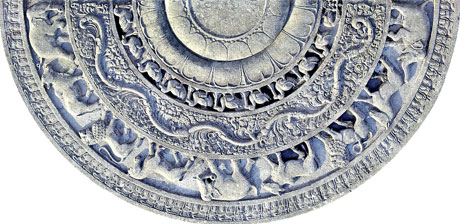Sandakadapahana
Symbolises the cycle of Samsara:
Known in Sinhalese as Sandakada pahana, it is roughly translated into
English as moonstone. The name is based on its shape and design. The
ancient chronicle Mahavamsa and Pali literature such as the
Samantapasadika refer to the Sandakada pahana as patika.
The first Sandakada pahanas were created during the latter stage of
the ancient Anuradhapura Kingdom. They were only placed at the entrances
to Buddhist temples during this period.

The carvings of the semi-circular stone slab were the same in every
Sandakada pahana. A half lotus was carved in the centre, which was
enclosed by several concentric bands. The first band from the half lotus
is decorated with a procession of swans, followed by a band with an
intricate foliage design known as liyavel.
The third band has carvings of four animals; elephants, lions, horses
and bulls. These four animals follow each other in a procession
symbolising the four stages in life: growth, energy, power and
forbearance. The fourth and outermost band contains a carving of flames.
The design of the Sandakada pahana of the Polonnaruwa period differs
largely from that of the Anuradhapura period.
The single band that was used to depict the four animals was removed,
and processions of the elephant, lion and horse were depicted in
separate bands. The most significant change is the removal of the bull
from the Sandakada pahana.
The Anuradhapura tradition of placing Sandakada pahanas only at
entrances to Buddhist temples also changed, and they are found at the
entrances of other buildings belonging to the Polonnaruwa period as
well. The Sandakada pahana at the entrance to the Polonnaruwa Vatadage.
Note the absence of the bull and lion.
An invasion by Rajendra I in 1017 AD brought a large part of the
country under the control of the Chola empire. The country was under
Chola rule until 1055 AD, and the Sri Lankan culture was heavily
influenced by South Indian customs and traditions, including the Hindu
religion.Historians believe that the reason for the removal of the bull
from the Sandakada pahana was because of its connection with Hinduism.
The bull, the vehicle of the god Shiva, is a venerated animal in
Hinduism, and therefore was removed from the Sandakada pahana since it
was a place where people tread upon.
The lion has also been omitted from some Sandakada pahanas.The best
specimen of the Sandakada pahanas of the Polonnaruwa period is at the
northern entrance of the Polonnaruwa Vatadage.
A Sandakada pahana of the Kandy period at the Degaldoruwa temple.
By the time of the Gampola and Kandy Kingdoms, the design of the
Sandakada pahana had changed drastically. The concentric bands were no
longer there, and the shape of the once semi-circular stone slab had
become almost triangular. A lotus was carved in the middle of the stone
slab, which was surrounded by an elaborate pattern.
Symbolism
Historians believe that the carvings of the Sandakada pahana
symbolise a religious meaning. The widely accepted interpretation is
that of historian Senarath Paranavithana. According to Paranavitana, the
Sandakada pahana symbolises the cycle of Samsara. The liyavel symbolise
worldly desires (Thanha) and the lotus depicts the final achievement of
Nirvana. The elephant, bull, lion and horse depict birth, decay, disease
and death.
-Internet |

